
|

|
| Use the text links for more information! |
| Trinity
At the end of South Street is the former Holy Trinity Church which closed in 1969
and depreciated until it was taken over by the White Ensign Club in 1977. The
Church Hall was in Friars Gate.
The church was built at the time the gate was demolished and consecrated in 1821. A plaque on the
wall of this church states that this was the site of the medieval south gate which was
demolished in 1819. The plaque states that King Henry VI entered the city here on 16th
July 1452. He will have entered via Magdalen Street which at the time afforded the most
direct route to and from London.
The gate included two prison's, a debtors prison in the east wing
and a felons (violent criminals) prison in the west wing. The remains of the Roman
south gate can be seen a short distance to the west of the plaque.
The Southgate Hotel Stands between South Street and Southernhay. This building was constructed in
the late eighties (opening in 1989), utilising 45 / 46 Southernhay East, a listed building and formerly the home
of Trinity Coach Works. These buildings can be seen in the picture opposite.
Prior to it's construction, there was a scrap yard (Newberry's) and Trinity Cottages,
a row of 8 cottages in Trinity Street. The street and cottages were demolished though the City Wall Walk follows
the old line of Trinity Street.
|
|
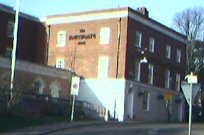 The hotel's site is believed to have been the location of Exeter's famous Lammas Fair which was a 3 day annual market. An archaeological dig carried out prior to construction of the hotel revealed several artifacts and the presence of a previously unknown defence ditch dating to the Civil war. The hotel was originally named the Forte Crest Hotel changing to the Southgate Hotel in 1996 when the hotel ownership changed. 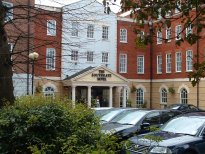 Dean Clarke House, formerly the Devon and Exeter Hospital is adjacent to this area. Dean Clarke was the founder of the hospital, the foundation stone was laid in 1741. |
| Not Inn
Left around the corner in Magdalen Street, you'll see
Tiggas, formerley
The Branch Office on the end of a traffic island
/ car park. This is your next historic pub stop. Unfortunately the pub is not that historic having only been
built in the mid 1960's. It was previously the Acorn which was a gay pub. It became The Branch Office in the mid nineties
and Judge Jefferies in 2004 in anticipation presumably of the
new law courts opening just down the road.
An original Acorn Inn stood in Magdalen St before the re-modelling of the roads in the 1960's. It was subsequently
re-built on this traffic island. It was alot smaller back then.
Many of the buildings at the top end of Holloway Street and in Magdalen Street were built after
the Civil War when the area had been levelled by
order of the defenders of the city, fearing General Fairfax might attack the city from this side in 1645.
Another Inn that stood at the top of Holloway Street (now gone) was the Valiant Soldier named to commemorate
those who had died during the civil war.
|
|
|
|
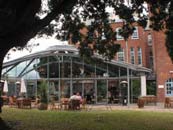 |
Infirmary
Opposite the pub is the Hotel Barcelona, renovated from the
West Of England Eye Infirmary
(the building became part of Exeter University for a while). The infirmary was founded in 1808 in Holloway Street, moving to
Magdalen Street in 1813. It was rebuilt in 1901 by Sir Alfred Brummel Thomas. The 42 room Hotel opened early 2001 retaining
many of it's original features. Inside is the Cafe
Paradiso another trendy cafe bar and restaurant. This bar is something else if you're interested in modern
architecture and was added at the time the place converterted to a hotel. The structure is of steel and glass and is well
worth a visit. One word of warning though, its' a buffoons paradise. There is also the Kino Bar, which
as you might expect is a cocktail bar but was originally the out-patients department. Kino is German slang for Cinema.
Wynards
Also of interest opposite the Hotel are the red Wynards Almshouses incorporating Trinity Chapel. This was
William Wynards Hospital for the Poor, built in 1430. They were damaged during the civil war and it was many years
before the Mayor was able to force the owner to put repairs in place. In 1789, William Kennaway (a wine merchant of
Palace Gate), bought the tennancy and had a burial vault excavated under the chapel. The Kennaways later had the entire
complex restored by architect Edward Ashworth and sculptor Harry Hems in 1856.
|
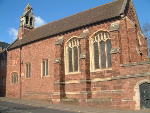 |
In 1950 patronage passed to the Exeter Municipal Charities but by 1967 they had applied for demolition. There was
obviously something seriously wrong with these cretins in the 1960's. Too much dope, too many dopes.
The buildings were rescued by the council who installed various voluntary organisations after modifications in 1972. Amongst other organisations, the buildings housed the Citizens Advice Bureau. These organisations have now left the premises and Wynards was put up for sale in May 2001. The site was bought and converted into 12 two and three bedroom townhouses, up for sale in 2002. Owners were advised that there would be guided tours through their courtyard. William Wynard was Recoder for Exeter between 1418 and 1442, he kept rooms at the White Hart Inn in South Street, then known as The Blue Boar Inn. |
| Bull Just down Magdalen Street on the right is Bull Meadow, taking it's name from the Bull Inn which stood nearby in the C17th. It was designated as a pleasure ground in 1989 by the council under the Public Health Act of 1875 and it's current shape was largely determined by the building of Magdalen Bridge in 1832. As you can imagine, a fair bit of earth moving and landfill went into the construction of this bridge and containment of Sutbrook or Barnfield Brook which flows beneath the pleasure grounds. The stream actually flowed through the right hand arch of the bridge and also through what is now the large car park at the end of Magdalen Road. |
Carter Backtrack slightly to the other side of the traffic island and head down Holloway Street. Holloway Street used to be known as Carterne Street. When the Exe was blocked by Isabella De Fortibus and later Hugh de Coutenay who owned Topsham Docks, trade at Exeter's quayside virtually ceased until the canal returned ships to the quayside in 1575. Goods had to get to and from Topsham and they did so along Cartene Street and what is now seen as Topsham Road. Cartene Street was where the Carters lived. Just a little way down used to stand the Windmill Inn which was demolished in 1885. |
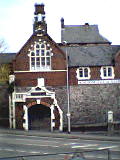
Jehovah and the Lark The Jehovah Witnesses occupy the old Holloway Street School built in 1876, this school was St Nicholas School for many years until it moved to newer premises behind this building. Don't stand here too long or you'll be handed a leaflet and a sermon. Just before you turn into Melbourne Street (about 100 metres second right), take a look at the old red building that is now 38 Holloway Street. Its the one with the gargoyle. This is all that is left of Great Larkbeare, demolished in 1889 to make way for Roberts Road amongst others. Just opposite until the mid 1970's was the Artillery Inn now the site of the new housing scheme. This is shown on the 1876 O.S Map. |
 |
Hour Glass
Follow the road and you'll come to the Hour Glass Inn. This is a great old
pub with a fine restaurant downstairs. Maps from 1774
and 1875 show a huge transformation in this area during the intervening years. Cloth racks used for the
wool
trade were replaced by large merchant's houses including the red-
brick Colleton Crescent which can be seen standing above the Quayside. The Napoleonic Wars
(1793-1815) ended
European trade and effectively put paid to the Devon Wool & Serge industry. The riverside developed new industries
including brewing, tanning, paper milling and iron foundries. The crescent was built by Nosworthy between
1802 and 1814 and named after John Colleton.
Colleton
Of particular interest on the ground floor of the Colleton Crescent buildings
are the Coade Stone surrounds to the windows and doors. Coade Stone is a particulary hard-wearing man-made stone formulated
by George Coade, a wealthy Exeter resident who eventually went bankrupt. The formula remained a secret until 1970.
The factory was in London.
John Colleton was yet another wealthy Exeter merchant. He introduced a species of Magnolia to England (from Carolina)
in 1737. His grand-daughter, Louisa laid the foundation stone for these buildings in 1802.
|
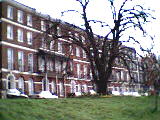 |
|
Nearby there are also other fine examples of C19th merchant's houses such as those in Melbourne
Place, Colleton Lodge, Friars Lodge, Colleton House and Southview as well as
New Theatre and the Salvation Army Temple.
That's about it for today, if you want more, pop in at the quayside pubs, you're not that far away now. Go down Colleton Hill to the river. Turn left for the Port Royal or right for the main Quayside area. Notice that the outfall of Sutbrook or Barnfield Brook or Shitbrook at the bottom of Colleton Hill. The cottages in Colleton Hill were once inhabited by the Lime Kiln workers who used to work nearby. Limestone was shipped in from Torbay and coal from the South Wales fields. Quicklime was produced for breaking down tough soils and to whitewash cottages. Stuart Callon Copyright ©2002 - 2005 |
|